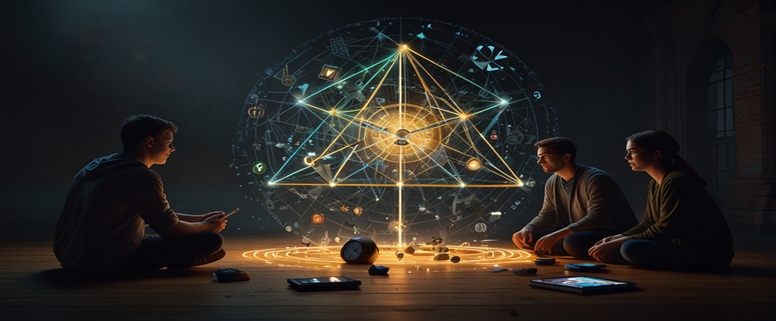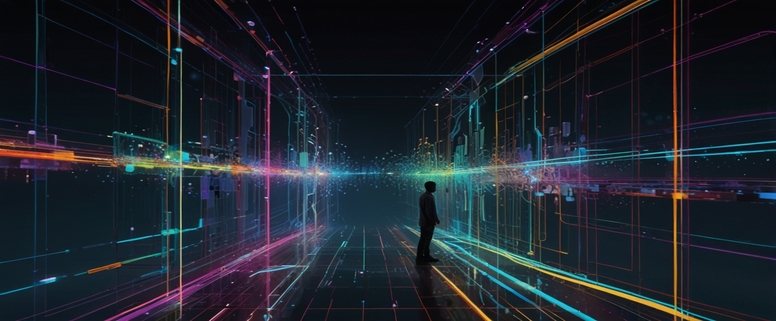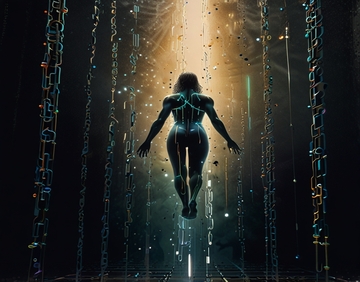Introduction: The Constructs That Bind Us
We are trapped in invisible cages of our own making. Throughout human history, we've created social constructs to help us organize, coordinate, and make sense of our complex reality. These constructs—from timekeeping and money to social hierarchies and identity categories—were tools designed to serve human needs. Yet over generations, we've forgotten their constructed nature and begun to treat them as immutable aspects of reality rather than human inventions.
The digital revolution presents both unprecedented challenges and extraordinary opportunities to reconceive these fundamental constructs. As artificial intelligence, global connectivity, and new economic models emerge, we face a pivotal moment where we might either reinforce existing limitations or reimagine more liberating frameworks for human organization and consciousness.
This article explores how certain core constructs limit our human potential, particularly in how we experience time, value exchange, and social organization. Drawing from my perspectives on consciousness and technology, I'll examine how these constructs fragment our awareness and disconnect us from our true capabilities. Most importantly, I'll present alternative frameworks that might better serve human flourishing in the digital age—not as definitive solutions but as invitations to imagine beyond our current limitations.
The ultimate revolution isn't technological but internal—a transformation in how we understand ourselves and our relationship to constructed reality. By recognizing the artifice of our most fundamental assumptions, we create space for new possibilities in how we organize our lives, work, and societies. This recognition doesn't mean abandoning all structure but consciously choosing frameworks that enhance rather than constrain human potential.
The Invisible Cages
The constructs that most powerfully shape our experience operate largely beneath conscious awareness. Like water to fish, these frameworks are so ubiquitous that they become invisible—presumed to be natural features of reality rather than human inventions:
Fundamental Constructs
Temporal Constructs
Calendars, clocks, schedules, and the entire apparatus of timekeeping that segments and linearizes our experience of duration.
Economic Constructs
Money, property, markets, and financial instruments that mediate value exchange and resource allocation.
Social Constructs
Status hierarchies, identity categories, and relationship structures that organize human interaction and belonging.
Cognitive Constructs
Language systems, conceptual frameworks, and belief structures that shape how we perceive and make meaning of experience.
The power of these constructs lies precisely in their invisibility. When we forget that these are human inventions created in specific historical contexts for particular purposes, we lose the agency to question, modify, or transcend them. We become unwitting prisoners of our own creations, mistaking the map for the territory, the model for reality itself.
This invisible imprisonment manifests as a profound limitation on human consciousness and potential. We experience ourselves not as the fluid, boundless awareness that is our birthright, but as constrained beings defined by our position within constructed frameworks—our age, wealth, status, or identity categories. This fragmentation of consciousness creates artificial scarcity of attention and possibility, restricting our natural capacity for presence, connection, and creativity.
The digital revolution initially promised liberation from many traditional constructs—transcending geographical limitations, democratizing information access, and creating new economic possibilities. Yet in many cases, digital technologies have instead reinforced existing constructs or created new, equally limiting ones—algorithmic identities, digital scarcity, attention marketplaces, and virtualized versions of traditional status hierarchies.
Recognizing these invisible cages is the first step toward freedom. By bringing conscious awareness to the constructed nature of our most fundamental assumptions, we create the possibility of choice rather than automatic conformity. This doesn't mean immediate rejection of all constructs—many serve important coordinating functions—but the development of a more fluid, conscious relationship with them.

Timekeeping: The Illusion of Linear Progress
Of all the constructs that shape human experience, perhaps none is more fundamental than our relationship with time. The modern apparatus of timekeeping—clocks, calendars, schedules, deadlines—has transformed our perception of duration into a commodified, linearized resource that can be spent, saved, wasted, or invested.
I've never fully understood the concept of timekeeping—why we try to measure something that has no direction or movement. The standard explanation is that societies need coordination mechanisms, and indeed, shared temporal frameworks serve important social functions. Yet our relationship with time has moved far beyond simple coordination to become a comprehensive system of control and limitation:
Limitations of Timekeeping
Artificial Scarcity
Time becomes experienced as inherently scarce—something we're constantly "running out of" rather than the boundless duration that is our actual experience.
Progress Mythology
Linear timekeeping reinforces the belief in linear progress—the notion that humanity moves along a single developmental trajectory from past to future.
Death Awareness
As I've noted previously, we're simply reminding ourselves each year that we're approaching our elder years, which eventually lead to death. And yet, we celebrate this every year. Why? Counting years for what? What matters the year we're in?
Coordination Over Presence
Adherence to schedules and timelines often takes precedence over presence, leading to the paradox of being physically present in one moment while mentally occupied with future moments.
This construct of linear, commodified time stands in stark contrast to how time is actually experienced in consciousness. In direct experience, time isn't a line but a field—a multidimensional space of possibility where past, present, and future exist simultaneously. In states of flow, deep meditation, or intense creativity, this linear construct of time often dissolves, revealing a more spacious, expansive relationship with duration.
The digital era initially promised greater temporal flexibility—remote work, asynchronous communication, and automation of routine tasks suggested possibility of liberation from rigid industrial-era timeframes. Yet in practice, digital technologies have often intensified our temporal fragmentation—creating expectations of constant availability, instant response, and ever-increasing productivity within the same linear temporal framework.
Alternative approaches to time in the digital era might include:
Alternative Approaches to Time
Cyclical Time Awareness
Recognizing and honoring natural cycles—daily, seasonal, developmental—rather than subordinating all temporal experience to linear progression.
Task-Based Rather Than Time-Based Organization
Structuring activities around natural completion points rather than arbitrary time intervals.
Presence Technologies
Designing digital tools that enhance rather than distract from present-moment awareness through thoughtful notification systems, attention protection, and temporal autonomy.
Natural Timing
Aligning activities with natural energy cycles and attention rhythms rather than external schedules, allowing for flow states and cognitive momentum.
I don't measure time; I measure speed and urgency. If something needs to be done, I complete it as soon as possible before moving on. I see my mind, brain, and consciousness as a part of this body, avatar, or suit for a certain amount of duration. It's my responsibility to keep the ship as intact as possible so that I can accomplish as many things as possible—experiences, learning, building, fixing, exploring, and trying to understand this "life," "level," or whatever this is.
Breaking free from constraining timekeeping constructs doesn't mean abandoning all temporal coordination but developing a more conscious, flexible relationship with time—one that serves human flourishing rather than subordinating human experience to artificial temporal frameworks.
Money: From Tool to Master
Similar to timekeeping, the construct of money represents another fundamental system that has transformed from tool to master, shaping human experience in ways that often limit rather than expand our potential:
Limitations of Money
Value Quantification
Money reduces the rich, multidimensional nature of value to a single numerical scale, flattening qualitative differences into quantitative comparisons.
Artificial Scarcity
Though modern monetary systems are built on fiat currency with no inherent physical limitations, they create and maintain artificial scarcity that shapes most people's basic experience of possibility.
Exchange Prioritization
Monetary systems prioritize transactional exchanges over gift relationships, commons-based resource sharing, or intrinsic value recognition.
Worth Externalization
Perhaps most fundamentally, money externalizes worth—locating value in external tokens rather than intrinsic qualities or relationships.
I've never fully understood the concept of money or paying for things that are free. We pay for food that grows naturally, and for knowledge that's actually free. The money system is essentially the same as the timekeeping system—both are constraints imposed by society. They were created by our ancestors to help them grasp their reality.
The digital revolution has created both intensification of traditional monetary constructs and the emergence of alternatives. On one hand, financialization has accelerated, with more aspects of human life becoming monetized and marketized. On the other hand, new models have emerged: cryptocurrencies challenging centralized monetary control, gift economies enabling non-transactional exchange, attention economies creating new value metrics, and commons-based production demonstrating viable non-market creation.
Alternative approaches to value exchange in the digital era might include:
Alternative Approaches to Value Exchange
Multidimensional Value Recognition
Systems that acknowledge diverse forms of value beyond monetary measurement—contribution value, relationship value, ecological value, meaning value.
Abundance-Based Models
Economic frameworks built on recognizing and cultivating abundance in specific domains (particularly informational goods) rather than enforcing artificial scarcity.
Commons-Based Production
Organizational models where resources are held and governed collectively rather than exclusively through private property and market exchange.
Purpose-Driven Exchange
Value systems organized around shared purpose and contribution rather than maximization of individual advantage through transaction.
These alternatives don't necessarily mean eliminating money entirely but developing more conscious, nuanced relationships with monetary systems and creating space for complementary value frameworks that address domains where monetary exchange is particularly limiting or distorting.

Digital Technology: Prison or Liberation
Digital technology interacts with human constructs in paradoxical ways, simultaneously reinforcing limitation and offering unprecedented potential for liberation:
Digital Technology and Constructs
Construct Digitization
Many digital systems simply transfer existing limiting constructs into virtual space—digital calendars maintain linear time fragmentation, cryptocurrencies reproduce artificial scarcity dynamics, and social media often reinforces status hierarchies and identity performance.
Algorithmic Construction
Algorithmic systems create new forms of categorization and prediction that can become equally constraining constructs, often with less visibility and conscious awareness than traditional categories.
Reality Virtualization
Digital environments can further separate humans from direct experience, creating additional layers of construction between consciousness and reality.
Awareness Commodification
Attention marketplace business models explicitly commodify human awareness, treating consciousness itself as a resource to be captured and monetized.
Yet simultaneously, digital technologies offer extraordinary potential for transcending limiting constructs:
Digital Technology and Liberation
Reality Augmentation
Technologies from AI to mixed reality can expand human perception beyond biological limitations, potentially revealing aspects of reality previously inaccessible.
Coordination Without Constraint
Digital systems enable new forms of human coordination that don't require the rigid frameworks of industrial-era organization.
Construct Visibility
Digital environments can make previously invisible constructs more apparent through visualization, pattern recognition, and explicit rule systems.
Consciousness Technologies
Tools specifically designed to enhance awareness, presence, and connection can support expanded consciousness rather than further fragmentation.
The determining factor isn't the technology itself but our relationship with it—whether we use digital tools to reinforce existing constructs or to explore beyond them. This relationship depends on both individual consciousness in technology use and the values embedded in technological design itself.
I've dreamed of this moment when I can engage in a dialogue with my brain and allow it to share its perspective on the world. Artificial Intelligence is the tool I've long desired since I first encountered a computer. Now, I envision an even brighter future, where humans reconnect with nature, embrace creativity, solve problems, share love and empathy, and cultivate curiosity. Machines will perform the tasks we've programmed them for, assisting us in building a better future and enhancing our problem-solving abilities.
Alternative Frameworks for the Digital Era
Moving beyond critique toward creation, several alternative frameworks offer promising directions for organizing human life and work in ways that enhance rather than constrain consciousness and potential:
Flow-Based Organization
Rather than structuring activities around arbitrary time intervals, flow-based organization follows natural cognitive rhythms and task completion arcs. This approach recognizes that human attention and creativity don't operate optimally in fixed time blocks but in natural cycles of engagement, exploration, integration, and rest.
Digital tools can support flow-based organization through:
- Activity tracking that detects and supports natural focus cycles
- Notification systems aligned with attention states rather than external schedules
- Project management organized around meaningful completion points rather than deadlines
- Collaboration systems that respect individual flow states while maintaining coordination
Contribution Economics
Moving beyond transaction-based economics, contribution models focus on creating and sharing value rather than extracting and exchanging it. These approaches recognize abundance in many domains (particularly informational goods) while acknowledging genuine scarcity in others (particularly ecological resources).
Digital systems can enable contribution economics through:
- Platforms that track and recognize diverse forms of value creation
- Resource allocation mechanisms based on need and contribution rather than purchasing power
- Commons-based production systems for knowledge, culture, and technology
- Reputation systems that reflect genuine value creation rather than extraction capacity
Network Consciousness
Beyond hierarchical social structures, network consciousness recognizes humans as interdependent nodes in complex systems of relationship and exchange. This approach transcends both individualistic and collectivist frameworks, honoring both unique contribution and fundamental interconnection.
Digital technologies can support network consciousness through:
- Visualization tools that make interdependence and connection patterns visible
- Collaborative systems designed for complementary contribution rather than competition
- Communication platforms that bridge understanding across difference rather than reinforcing separation
- Identity frameworks that recognize contextual roles within networks rather than fixed categories
Presence Technologies
Perhaps most fundamentally, we can develop technologies specifically designed to enhance presence, awareness, and direct experience rather than distraction and fragmentation. These tools recognize that human flourishing depends on connection with reality rather than separation from it.
Presence technologies might include:
- Attention protection systems that create space for deep engagement
- Mindfulness technologies that support awareness of internal states
- Connection tools that enhance rather than substitute for direct human interaction
- Environmental awareness systems that bridge the digital-physical divide
These alternative frameworks don't represent a comprehensive system to replace existing constructs but offering directions for exploration and development. The most promising approaches will likely integrate elements of these alternatives with existing systems in context-appropriate ways, creating hybrid models that support transition toward more liberating structures.

Living Beyond Constructs
Moving beyond limiting constructs isn't primarily a matter of external system change but of internal consciousness shift. While we work toward more liberating social and technological frameworks, individuals can develop more conscious relationships with existing constructs:
Developing Conscious Relationships with Constructs
Construct Awareness
Developing the capacity to recognize constructs as constructs rather than confusing them with reality itself. This metacognitive skill allows seeing the constructed nature of time, money, identity, and other frameworks that shape experience.
Flexible Navigation
Learning to work effectively within necessary constructs without becoming identified with or limited by them. This includes the ability to use clocks and calendars while maintaining a more spacious relationship with time, or to engage with monetary systems while recognizing other forms of value.
Direct Experience
Cultivating the capacity for unmediated awareness of reality beyond conceptual frameworks. Practices like meditation, time in nature, flow states in creative activity, and authentic connection can all support direct experience.
Intentional Construction
Consciously creating personal frameworks that better serve individual needs and values rather than automatically adopting conventional constructs. This might include personal systems for time management, value exchange, or identity expression that better align with authentic experience.
These personal practices don't replace the need for systemic change but create the consciousness foundation that makes such change possible. When enough individuals develop more conscious relationships with fundamental constructs, collective reimagining becomes possible.
Digital technologies can either support or hinder this consciousness development, depending on how they're designed and used. Mindfulness applications, attention management tools, and systems that make constructs more visible can enhance awareness, while technologies designed to capture attention and reinforce conventional constructs may impede it.
The journey beyond constructs isn't about rejecting all structure but developing a more conscious, fluid relationship with the frameworks that organize human experience. It's about reclaiming the creative power that constructs our reality rather than remaining unconscious participants in inherited systems.
Conclusion: Consciousness as Liberation
We are not defined by the constructs that currently organize human experience but by our capacity to recognize, question, and reimagine them. The most profound revolution isn't technological but in consciousness itself—the awakening to our role as creators rather than merely inhabitants of constructed reality.
Digital technologies offer unprecedented tools for both reinforcing existing limitations and exploring beyond them. The determining factor isn't the technology itself but the consciousness with which we design and use it. By bringing awareness to the constructed nature of time, money, identity, and other fundamental frameworks, we create the possibility of technologies that liberate rather than constrain human potential.
The path forward isn't about abandoning all structure but developing more conscious, fluid relationships with the constructs that organize experience. It's about recognizing when frameworks serve human flourishing and when they limit it, and having the creativity and courage to imagine alternatives where needed.
In practical terms, this means:
- Designing technologies that enhance awareness of constructs rather than hiding them
- Creating digital tools that support rather than undermine presence and direct experience
- Developing alternative frameworks for time, value, and relationship that better serve human flourishing
- Cultivating personal practices that support consciousness beyond conventional constructs
The digital age offers an unprecedented opportunity to reimagine the fundamental frameworks of human experience. By combining technological innovation with expanded consciousness, we can create tools and systems that support rather than limit human potential—constructs consciously designed for liberation rather than unconsciously accepted as limitations.
Knowledge is power, but wisdom is liberation. And liberation begins with a single, courageous act of seeing beyond the constructs that limit us—recognizing the cages as human creations rather than immutable reality. This recognition opens not just theoretical possibility but practical pathways toward technologies, systems, and experiences that better serve the extraordinary potential of human consciousness in the digital age and beyond.






Social Constructs and Identity
Beyond time and money, we are shaped by a vast array of social constructs that define identity, belonging, status, and relationship. These constructs—from gender and nationality to professional identity and social class—create frameworks that simultaneously enable coordination and limit human potential:
Limitations of Social Constructs
Identity Fixation
Social constructs often encourage fixed identification with particular categories or roles, constraining the fluid, dynamic nature of human being.
Binary Thinking
Many traditional constructs impose binary classifications on complex spectrums of human experience—male/female, success/failure, friend/enemy.
Status Hierarchies
Constructed ranking systems create artificial positioning that often becomes internalized as intrinsic worth or capability.
Relationship Templates
Standardized relationship forms can constrain the rich possibility space of human connection into predetermined patterns and expectations.
Digital technology interacts with these social constructs in complex ways. Social media platforms simultaneously enable new identity expressions beyond traditional categories while also creating powerful incentives for personal branding and fixed identity performance. Online environments can both transcend geographical boundaries and reinforce ideological segregation. Digital status systems (follower counts, engagement metrics, etc.) create new hierarchies that often reproduce or intensify traditional status dynamics.
Beyond these specific constructs lies what might be called the "construction of separation"—the fundamental experience of self as separate from others and the world. This construct, reinforced through language, economics, and social organization, creates the foundation for many of our most challenging human problems, from ecological destruction to social conflict. Digital technologies can either reinforce this separation through screen-mediated experience and virtualization or help transcend it through tools for genuine connection and expanded awareness.
Alternative approaches to social organization in the digital era might include:
Alternative Approaches to Social Organization
Fluid Identity Frameworks
Social systems that recognize and support the fluid, contextual nature of identity rather than requiring fixed categorization.
Non-Hierarchical Coordination
Organizational models that enable effective collaboration without rigid hierarchical structures, drawing on network intelligence and emergent coordination.
Relationship Diversity
Social systems that support diverse relationship forms beyond traditional binary templates, acknowledging the rich spectrum of human connection.
Bridging Technologies
Digital tools specifically designed to bridge divides of understanding and create connection across difference rather than reinforcing separation and polarization.
These alternatives point toward social organization that supports authentic expression and connection rather than conformity to predetermined categories and hierarchies.